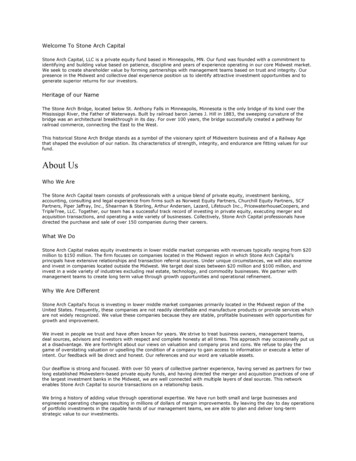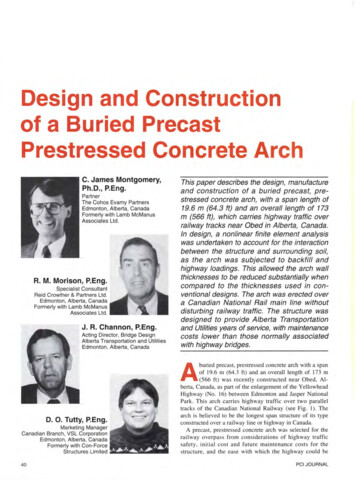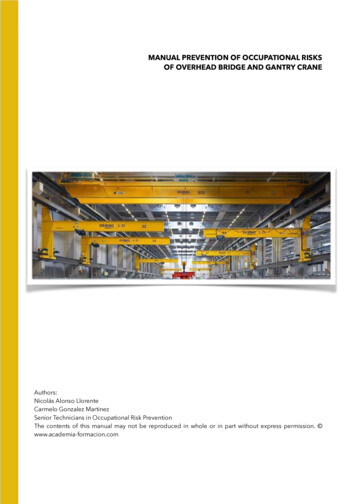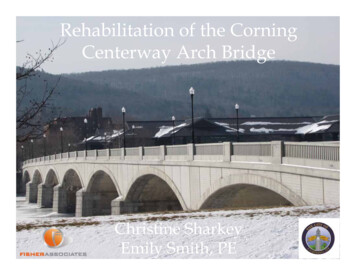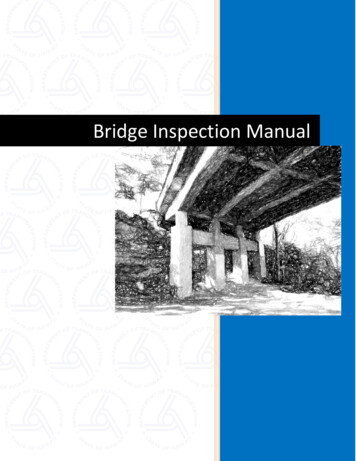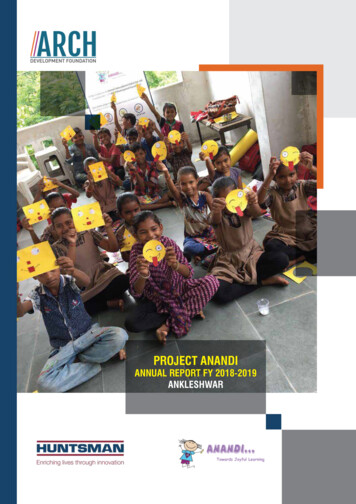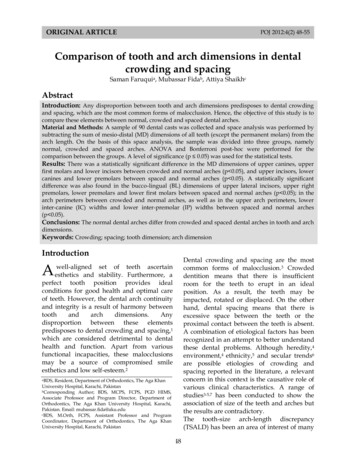
Transcription
PENNDOTSTONE ARCH BRIDGEMAINTENANCE MANUALOCTOBER 2007
PENNDOTSTONE ARCH BRIDGEMAINTENANCE MANUALPrepared for:Project KeystonePennsylvania Department of TransportationEngineering District 6-0Prepared by:SKELLY and LOY, Inc.Engineers-ConsultantsMonroeville/Harrisburg, PAandDMJM HarrisHorsham, PAOCTOBER 2007Cover:The Belmont Avenue (S.R. 3005) Bridge,a single-span arch bridge in Fairmount Park,Philadelphia.
TABLE OF CONTENTSPage1.0INTRODUCTION. 12.0COMPONENTS OF A STONE ARCH BRIDGE. 32.12.23.0BUILDING WITH STONE AND MORTAR. 63.13.23.33.43.53.64.0Stone Arch Bridge Components . 3Stone Arch Bridge Character-Defining Elements . 3Reference Works. 6Needed Skills . 6General Guidelines on the Use of Building Stone on Stone Arch Bridges . 6General Guidelines for Repairs on Stone Arch Bridges . 6Mortar . 73.5.1 Mortar Mixes for Stone Arch Bridges. 83.5.2 General Guidelines for Using Mortar . 8General Treatments Not Recommended for Stone Arch Bridges . 9TREATMENT OF STONE ARCH BRIDGES. 104.14.24.3Recommended Maintenance Program for Stone Arch Bridges. 104.1.1 Clearing Vegetation . 114.1.1.1 Clearing Vegetation - Treatment Recommended . 114.1.2 Improving Drainage and Reducing Water Infiltration . 114.1.2.1 Improving Drainage - Treatment Recommended . 114.1.2.2 Reducing Water Infiltration - Treatment Recommended . 124.1.3 Removing Debris from Substructure Elements and the Arch Opening. 134.1.3.1 Removing Debris - Treatment Recommended . 13Repairing, Rehabilitating, and Restoring Stone Arch Bridges . 134.2.1 Repairing and Rehabilitating Stone Arch Bridges. 134.2.2 Restoring Missing Elements to a Stone Arch Bridge . 13Repair, Rehabilitation, and Restoration Treatments. 144.3.1 Repointing . 144.3.1.1 Repointing - Treatment Recommended. 144.3.1.2 Repointing - Treatment Not Recommended . 164.3.2 Repairing Spalling and Delaminated Stones . 164.3.2.1 Repairing Spalling and Delaminated Stones - TreatmentRecommended . 164.3.2.2 Repairing Spalling and Delaminated Stones - TreatmentNot Recommended. 174.3.3 Replacing Missing or Loose Stones . 174.3.3.1 Replacing Missing Stones - Treatment Recommended . 174.3.3.2 Replacing Loose Stones - Treatment Recommended. 184.3.3.3 Replacing Missing or Loose Stones - TreatmentNot Recommended. 184.3.4 Removing Concrete, Gunite/Shotcrete, or Other InappropriateExterior Coatings . 184.3.4.1 Removing Concrete, Gunite/Shotcrete, or Other InappropriateExterior Coatings - Treatment Recommended . 184.3.4.2 Removing Concrete, Gunite/Shotcrete, or Other InappropriateExterior Coatings - Treatment Not Recommended. 19i
TABLE OF ng Damaged or Missing Parapets and Coping. 194.3.5.1 Repairing/Rehabilitating Damaged Parapets and Coping Treatment Recommended . 194.3.5.2 Restoring Missing Parapets and Coping - TreatmentRecommended . 204.3.5.3 Restoring Missing Parapets and Coping Stones - OtherAcceptable Treatment . 204.3.5.4 Parapets and Coping - Treatment Not Recommended . 214.3.6 Repairing/Rehabilitating Damaged or Missing Spandrels . 214.3.6.1 Repairing/Rehabilitating Spandrels - TreatmentRecommended . 224.3.6.2 Restoring Missing Spandrels or Spandrel Sections Treatment Recommended . 234.3.6.3 Spandrels - Treatment Not Recommended . 244.3.7 Repairing/Rehabilitating the Arch Ring and Arch Barrel. 244.3.7.1 Repairing Longitudinal Cracks in the Arch Barrel Treatment Recommended . 254.3.7.2 Repairing/Rehabilitating Arch Rings and Arch Barrels withExcavation - Treatment Recommended . 264.3.7.3 Repairing/Rehabilitating Arch Rings and Arch Barrels withExcavation - Other Acceptable Treatment. 274.3.7.4 Restoring Arch Rings and Arch Barrels - TreatmentRecommended . 274.3.7.5 Arch Rings and Arch Barrels - Treatment NotRecommended . 284.3.8 Fill Material . 284.3.8.1 Recommended Replacement of Fill Material whenRepairing, Rehabilitating, or Restoring a Bridge. 284.3.9 Abutments, Piers, and Wing Walls . 294.3.9.1 Repairing/Rehabilitating Substructure Elements Treatment Recommended . 294.3.9.2 Substructure Elements - Treatment Not Recommended. 294.3.10 Scour Protection . 304.3.11 Decorative Features . 314.3.11.1 Repairing/Rehabilitating/Restoring a Decorative Feature Treatment Recommended . 314.3.11.2 Repairing/Rehabilitating/Restoring a Decorative Feature Treatment Not Recommended . 31SOURCES . 33APPENDIXESAPPENDIX AAPPENDIX BGlossary of TermsEstimated Repair/Rehabilitation Costs for Stone Arch Bridgesii
1.0 INTRODUCTIONThis manual provides guidance to state and local bridge forces on maintaining, repairing,rehabilitating, and restoring stone arch bridges. The manual was developed as part of ProjectKeystone, a management plan designed to identify a portion of the stone arch bridges in theGreater Philadelphia region, which is Pennsylvania Department of Transportation (PennDOT)Engineering District 6-0, for long-term preservation. The guidelines, however, are broadlywritten and applicable to stone arch bridges throughout the Commonwealth.Stone arch bridge technology represents the earliest extant bridge type in theCommonwealth. The time-tested technology was used in the state from the earliest days ofsettlement into the 1940s. Remaining examples in PennDOT Engineering District 6-0 date from1697 through the mid-twentieth century, and represent the largest collection of stone archbridges in the Commonwealth and one of the largest in the nation.Stone arch bridges are often historically and culturally important to the local community.Consequently, there is value in preserving and sensitively treating stone arch bridges, within thelimits of acceptable engineering and safety standards. Bridge owners must weigh a variety offactors in any decision to maintain, repair, rehabilitate, or replace a stone arch bridge. Thephysical condition of the bridge; the type and volume of traffic it must carry; its geometricfeatures; its historic significance; the development pressures around it; the hydraulic capacityand clearance beneath it; the cost of maintenance, repair, or replacement; public safety; andpublic sentiment all must be taken into account.The framework for this manual is the Secretary of the Interior’s Standards forRehabilitation (National Park Service 2001). These standards provide guidance on maintainingand repairing historic resources. Ten basic principles have been created to help preserve thedistinctive character of a historic resource, while allowing for reasonable change to meet newneeds. As originally construed, the Secretary’s Standards were most applicable to historicbuildings. The Virginia Transportation Research Council, in its Management Plan for HistoricBridges in Virginia (Miller et al. 2001), adapted the standards to address the specialrequirements of historic bridges. The adapted standards are presented on the following page.This manual uses these guidelines, plus information from a variety of other publications (seeReferences) to develop techniques to maintain, repair/rehabilitate, and reconstruct stone archbridges.1
Guidelines for Historic Bridge Maintenance and RehabilitationBased on the Secretary of the Interior’s Standards11.Every reasonable effort shall be made to continue an historic bridge in usefultransportation service. Primary consideration shall be given to rehabilitation of the bridge onsite. Only when this option has been fully exhausted shall other alternatives be explored.2.The original character-defining qualities or elements of a bridge, its site, and itsenvironment should be respected. The removal, concealment, or alteration of any historicmaterial or distinctive engineering or architectural features should be avoided.3.All bridges shall be recognized as products of their own time. Alterations that have nohistorical basis and that seek to create a false historical appearance shall not be undertaken.4.Most properties change over time; those changes that have acquired historicsignificance in their own right shall be retained and preserved.5.Distinctive engineering and stylistic features, finishes, and construction techniques orexamples of craftsmanship that characterize an historic property shall be preserved.6.Deteriorated structural members and architectural features shall be retained andrepaired, rather than replaced. Where the severity of deterioration requires replacement of adistinctive element, the new element should match the old in design, texture, and other visualqualities and where possible, materials.Replacement of missing features shall besubstantiated by documentary, physical, or photographic evidence.7.Chemical and physical treatments that cause damage to historic materials shall not beused. The surface cleaning of structures, if appropriate, shall be undertaken using the mostenvironmentally sensitive means possible.8.Significant archeological and cultural resources affected by a project shall beprotected and preserved. If such resources must be disturbed, mitigation measures shall beundertaken.9.New additions, exterior alterations, structural reinforcements, or related newconstruction shall not destroy historic materials that characterize the property. The new workshall be differentiated from the old and shall be compatible with the massing, size, scale, andarchitectural features to protect the historic integrity of the property and its environment.10.New additions and adjacent or related new construction shall be undertaken in such amanner that if removed in the future, the essential form and integrity of the historic propertyand its environment would be unimpaired.1A.B. Miller, K.M. Clark, and M.C. Gaines, Final Report for Historic Bridges in Virginia (VirginiaTransportation Research Council, Charlottesville, Virginia, 2001).2
2.02.1COMPONENTS OF A STONE ARCH BRIDGEStone Arch Bridge ComponentsStone arch bridges are built in courses of stone. Figure 1 illustrates the componentparts of a stone arch bridge. The load is carried by the arch barrel. The outer rings of the barrelare generally composed of cut-and-matched, wedge-shaped stones called voussoirs. Thevoussoirs are held in place by the keystone. Abutments and piers, substructure elements,absorb the thrust placed on the arch and transfer it to the ground. Wing walls are extensions ofthe abutments designed to retain side slope material from the approaches. The spandrels areexterior walls that surround the arch barrel and act as retaining walls for fill material, whichcarries the roadway. The portions of the spandrel walls above the roadway are called theparapets. In most cases, flat stones known as coping top the parapets. On some bridges, adecorative band of stone work called the belt course or stringcourse differentiates between thespandrels and the parapets. The bridge’s stones are bonded together by a cementitiousmixture called mortar. Early mortars consisted of sand, lime, and water. Other mortar mixturesinclude slag cement and Portland cement. The outer mortar material is called pointing. Thehorizontal mortar layers between stones are referred to as beds; the vertical layers are calledjoints. Replacing deteriorated exterior mortar is known as repointing.Stone arch bridges can feature a variety of decorative treatments. These includerecessed spandrel walls, recessed voussoirs, curved wing walls, pilasters, buttresses, towers,and look-outs.Three broad categories can be used to describe the methods of finishing the stonesurfaces of the bridge. Rubble stone bridges consist of rough, unsquared stone. The stone isleveled off at specific heights to an approximately horizontal surface. Squared stone masonryconsists of stones roughly squared and dressed. Ashlar is precisely squared and finely dressedstone. Ashlar can be worked to produce a variety of finishes.Definitions for italicized words are provided in the Glossary of Terms, located inAppendix A.2.2Stone Arch Bridge Character-Defining ElementsAll historic resources have character-defining elements, those essential physicalfeatures that are important in conveying their historical, cultural, or architectural values.Identifying, retaining, and preserving the character-defining elements of a resource type areimportant first steps in maintaining and preserving the historic character. The character-definingfeatures of a stone arch bridge are these: Voussoir ArchStone material, its cut and coursingStone abutments and wing wallsArch BarrelParapet height and shapeIt is essential that repairs or rehabilitation do not damage or destroy the materials, features, andfinishes that are important in defining the character of the stone arch bridge. Original decorativeelements or non-original elements that have obtained a historical significance over time, likethose enumerated in the preceding section, add an aesthetic component to the bridge and3
4
become character-defining elements in their own rights. Decorative treatments should berespected in the course of completing repairs, rehabilitations, or restorations.By contrast, the roadway surface and the fill material employed to support it are notcharacter-defining elements of a stone arch bridge. Replacing these components to strengthena bridge or improve its drainage will not adversely affect its historical or architectural character.5
3.0 BUILDING WITH STONE AND MORTAR3.1Reference WorksStone and mortar are building materials that require special preparation and treatment inorder to ensure the best possible bond between the elements, and thus provide the bridge withthe necessary strength and durability. A number of reference books are available that providedetailed information on building and repairing in stone. Two of the most useful are:Cramb, Ian1992 The Art of the Stonemason. Betterway Books, Cincinnati.McRaven, Charles, and Chandis Ingenthron1989 Building with Stone. Storey Books, North Adams, Massachusetts.3.2Needed SkillsIn general, the maintenance functions described in Section 4.2 can be undertaken bylaborers working under the supervision of a maintenance foreman. Repairs and rehabilitationsof stone arch bridges should be completed under the direction of a professional engineer.Repair and rehabilitation work should be supervised by a mason experienced in the stone work,in shaping and coursing stones, and in the use and mixture of mortar. Generally, the mason willneed one or more laborers to assist with tasks such as transporting stones, mixing mortar, andlaying the stones.3.3General Guidelines on the Use of Building Stone on Stone Arch BridgesThere is great variety in building stone. Structural stone varies in content, color,structure, workability, strength, and durability. When treating historic stone arch bridges, thefollowing general guidelines apply to building stones:3.4 Ideally, bridges should be repaired using the original stones, if possible. If it is not possible to use the original stones, the replacement stones should matchthe existing stones in type, size, texture/finish, and color.General Guidelines for Repairs on Stone Arch BridgesWhen repairing or rehabilitating stone arch bridges, all work should be performed inaccordance with Publication 55 (PennDOT 2002), Publication 408 (PennDOT 2003), andChapter 14 of Bulletin 15 (PennDOT 2006), and the following general guidelines: All repair, rehabilitation, and restoration projects should be undertaken cautiouslyand only when necessary and specified in the biennial bridge safety inspectionreport. In general, all repairs should be undertaken using the least obtrusive meanspossible, with a plan to disturb the least amount of original material; unnecessaryrepairs and replacements should be avoided.6
3.5 All stone work, even random rubble, is built in courses, with the lift or height of eachlevel typically being approximately 18 to 24 inches. To break the monotony ofstraight, long lines (known as levels), risers (stones that rise above or through theline) were often placed at fairly regular intervals. A bridge should be studied anddocumented through photographs and (if necessary) engineering drawings prior tobeginning treatment to discern and create a visual record of workmanship and theconditions to be addressed. The original pattern should be replicated as much aspossible in the course of the repairs. Where repair or rehabilitation is necessary, the work should use original materialwherever possible. If it is not possible to use original material, in-kind materialshould be used; if replacement of a missing element is required, the replacementshould also be in-kind. Stones used should match existing stones in type, size,texture/finish, and color. All stones should be clean, durable, properly quarried, and free from structuraldefects. Stones should be thoroughly saturated with clean water prior to beginning work, butno standing water should be present. Dry stones draw moisture from the mortar,causing it to dry out and crack. When undertaking large repairs and reconstruction, build up at 18 to 24 inchincrements; do not finish point until all construction is complete. The process is buildup, point, and clean down upon completion. When laying stones, place each so that it would stay in place even without mortar;mortar is a binding, not a glue. Stones should be well-bedded in the mortar, andplaced without hammering or jarring any stone already in place. Document all repair/rehabilitation work, including date, limits of work, and adescription of the work undertaken.MortarMortar consists of binders (such as cement and lime), aggregates, and water. It is asacrificial material that is expected to be replaced through repointing over time. It is preferredthat mortar deteriorates rather than the adjacent stones. Mortar acts as a bonding and fillingagent that binds the stones together in one mass, strengthening the structure. A stiff, semiliquid form when applied, mortar can conform to all irregular spaces between stones, distributingweight and stress evenly. When cured, it acts in concert with the stones. Mortar keepsmoisture from penetrating between stones and draw moisture that has penetrated back out. Italso keeps seedlings and roots, which will crack a wall as they grow, from infiltrating the bridge.Keeping mortar in good repair is an essential part of extending the life of a bridge.7
3.5.1Mortar Mixes for Stone Arch BridgesDepending on the date of construction, a variety of binders may be present in themortar of stone arch bridges, including earth and clays; lime; natural cements; hydrauliccements; other manufactured cements; Portland cement; and masonry cements. Thetype of binder used significantly affects the characteristics and performance attributes ofthe mortar. For example, mortars made with lime binders generally have lowercompressive strength, lower bond strength, and greater permeability than mortarscontaining Portland cement binders. Mortars with high lime content also have the abilityto re-seal small hairline cracks, provide greater prevention against rain penetration, andallow moisture that has penetrated the masonry to escape. However, they take longer tocure and reach full compressive strength. By contrast, mortar mixes containing highPortland cement ratios cure and reach full compressive strength quickly, but they lackthe flexibility of lime-based mortars and tend toward hairline cracks as the mixture dries,which allows moisture to penetrate the structure. As the moisture freezes and thaws,stones can be pushed apart and out of place. Mortars with high Portland cement ratioscan also cause sandstones, granites, and limestones to decay. For these reasons,mortars with high Portland cement ratios are generally not recommended for repairinghistoric stone arch bridges.Mortar characteristics, such as compressive strength, permeability, and durabilityare related to its component elements and their proportions. When creating a repairmortar, the exact physical and chemical properties of the historic mortar are not of majorsignificance as long as the repair mortar can coexist with the historic mortar in asympathetic and supportive capacity and it is compatible with the type of stone used toconstruct the bridge. It must have a lower compressive strength and a greater vaporpermeability the masonry units of the bridges. Vapor permeability is defined as theability to move moisture from the interior of the structure back out into the atmosphere.For these reasons, this manual recommends mortar mixtures that may vary fromthe mortar recommended in Publication 408, Section 705.7. The design and selection ofa repair mortar for use on historic stone arch bridges should be based on the type ofstone present, the current site conditions, the intended use or use of the mortar(bedding, pointing, etc.), and the characteristics of the historic mortar. To determine theproper mortar mix, it may be necessary to analyze the composition of the historic mortar.Petrographic examination of samples of the historic pointing mortar can be used to helpdetermine the composition of the original mortar for use in developing a repointing mix.In some special case, detailed compositional analysis of a historic mortar may berequired. This type of analysis can be performed following methods of ASTM C1324,Standard Test Method for Examination and Analysis of Hardened Masonry Mortar.3.5.2General Guidelines for Using MortarWhen treating historic stone arch bridges, the following general guidelines applyto mortar: Repair mortar (repoint) only when there is evidence of deterioration.Evidence includes disintegrating mortar, cracks in the mortar joints, gaps atthe mortar/stone interface, loose stones, or damp walls.8
3.6 The repair should address only those areas of the bridge where deteriorationis present; sound mortar that is well-bonded to the adjacent masonry shouldnot be removed. Repoint using a mortar that is compatible with the historic mortar and whichmatches it in color, texture, and finish. Mortar should be stiff. Stiff mortar shrinks less and allows the stone to set upwithout squeezing the mortar out. Mortar is a good consistency when, if themixture is squeezed by hand, it does not run out. Mortar should not be allowed to dry out during use and should be reworked atintervals before being placed in joints. Retempering, or adding more water,should not be permitted.General Treatments Not Recommended for Stone Arch Bridges Using replacement stones that do not match the existing stones in type, size,texture/finish, and color. Using repair mortars that are incompatible with the type of stone or the historicmortar. Using repair mortars with a greater compressive strength and a lesser vaporpermeability the masonry units of the bridges Using mortar for repointing that does not match the historic mortar in color, texture,and finish. Using mortars with high Portland cement ratios. Repairing bridge components with concrete, gunite/shotcrete, or other historicallyinappropriate material.The application of exterior coatings, such as granite/shotcrete, can trap moisture,making the mortar susceptible to frost damage. Frost damage can cause cracks in thegunite/shotcrete and in the bridge mortar, leading to further water penetration andfreeze/thaw damage. Also, exterior coatings may not allow the stones to dry out, whichcan lead to spalling and delamination, and obscure or conceal problems that can beaddressed only if discovered during bridge inspections.9
4.0 TREATMENT OF STONE ARCH BRIDGESThe following sections provide guidelines for preserving/maintaining, repairing,rehabilitating, and restoring stone arch bridges.The first source of information available to the bridge owner is the bridge safetyinspection report, which lists both short-range actions (maintenance, preservation, or repair) andlong range actions (rehabilitation or complete reconstruction) needed by the bridge. Repairsshould be noted on Screen AH of Publication 100A (PennDOT 1995). Procedures andstandards for bridge repair are described in Publication 55 (PennDOT 2002). However,inspection reports need to be carefully reviewed, as several maintenance items related to stonemasonry structures are not well defined by Publication 55 BMS Activity Numbers.For bridges recommended as strong-candidates for long-term preservation, the ownershould consider the maintenance needs and more serious structural needs and develop a longrange plan to maintain the arch. Failure to develop and implement a preservation plan willgenerally relegate the bridge to eventual replacement. The decision to preserve or replace astone arch bridge must be made carefully using “context-sensitive” engineering techniques.Once a decision to preserve or restore a stone arch bridge has been made, thepreservation of the character-defining elements of the bridge -- the voussoir arch, the archbarrel, the coursing and cut of the stone material, the parapet height and shape, the stoneabutments and wing walls, and any decorative elements -- should be a priority, in order toprotect the bridge’s historical and architectural character. Wherever possible, structural andsafety considerations made to meet current engineering standards should be done in concertwith historic preservation concerns.4.1Recommended Maintenance Program for Stone Arch BridgesThe most cost-effective method of preserving stone arch bridges is to develop a programof routine maintenance. A routine maintenance program arrests problems before they developor threaten the continued viability of the bridge, reducing the need for and frequency of majorrepairs and the costs associated with the bridge. Routine maintenance can ultimately extendthe life of a stone arch bridge for a relatively small amount of money when compared to the costof repair and rehabilitation.Perhaps the most important maintenance measures involve arresting water infiltration.Many structural problems associated with stone arch bridges can be traced to an influx of water.It is critically important, therefore, that existing drainage systems be kept open, pointing bemaintained in good repair, and holes in the roadways and other places on the bridge berepaired quickly in order to limit water infiltration.A suggested program of routine maintenance is provided below. Some measures, suchas removing vegetation, cleaning joints, clearing drainage openings, and removing debris fromarch openings should be done a minimum of once a year, and more frequently if noted on thebiennial inspection report. Other measures, such as repointing, should be noted on the biennialinspection report and Screen AH of Publication 100A (PennDOT 1995) and done on an asneeded basis.10
4.1.1Clearing VegetationVegetation touching bridge surfaces, such as bushes or tree branches, can trapmoisture and not allow the bridge to dry out, potentially leading to mortar deterioration,cracks i
APPENDIX B Estimated Repair/Rehabilitation Costs for Stone Arch Bridges ii. 1.0 INTRODUCTION This manual provides guidance to state and local bridge forces on maintaining, repairing, rehabilitating, and restoring stone arch bridges. The manual was developed as part of Project

